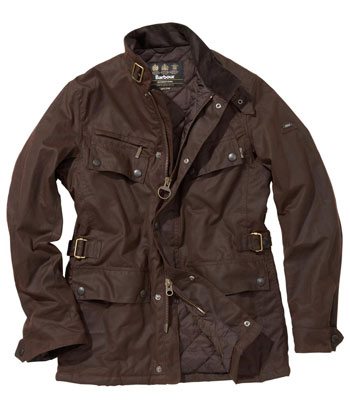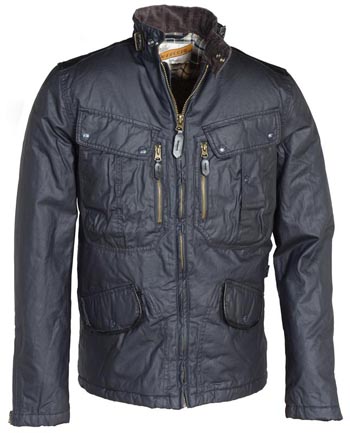The Slicker or Oilskin: The traditional fisherman’s coat falls to the mid-calves and has a wide, double-breasted front and an attached cape on the back. Most also include a hood that buttons beneath the chin. They are extremely protective, especially when paired with waders, but are heavy and not the most stylish choice.
 The Hunting or Hacking Jacket:
A thigh-length coat with a vent (slit) up the back to allow for riding.
Double- or single-breasted models are both common, going up to the neck
in either case and meeting a turndown collar. The collar is often done
in brown corduroy.
The Hunting or Hacking Jacket:
A thigh-length coat with a vent (slit) up the back to allow for riding.
Double- or single-breasted models are both common, going up to the neck
in either case and meeting a turndown collar. The collar is often done
in brown corduroy.The Field Jacket: A military style falling to just below the waist, with large front pockets and a built-in belt. Epaulets are common but not required.
The Moto Jacket: A tight-fitted, waist-length coat with a mandarin (non-turndown) collar and buttoning cuffs. Designed for motorcycle riding — Barbour in particular has a long-running association with cycling, dating back to the early 1930s.
 The Trench Coat:
The iconic military style: knee-length, built-in belt, epaulets and
storm flap. Waterproofed cotton and wool were the original materials for
the World War One-era trenchcoats that gave the style its name
The Trench Coat:
The iconic military style: knee-length, built-in belt, epaulets and
storm flap. Waterproofed cotton and wool were the original materials for
the World War One-era trenchcoats that gave the style its nameThere are many variations on all these basic styles. Hoods are quite common, as are all sorts of extra pockets designed for specific activities and items — shotgun shells, rolls of film, notebooks, and more.
Colors vary depending on brand and marketing, but earth tones are the most traditional. The original chemical process turned the cotton black or dark olive, which early manufacturers balanced with a brown corduroy collar, and all those are still quite common in modern waxed jacket styles.
In any cut or color, the sturdy, finished look of a waxed cotton jacket is a big selling point over more modern outdoors wear — unlike a brightly-colored plastic poncho, it looks like part of an outfit, rather than something draped over it. If you’re hiking the Appalachian Trail it probably doesn’t matter much; if you’re doing business in a big city you’ll be grateful for the added class.

No comments:
Post a Comment